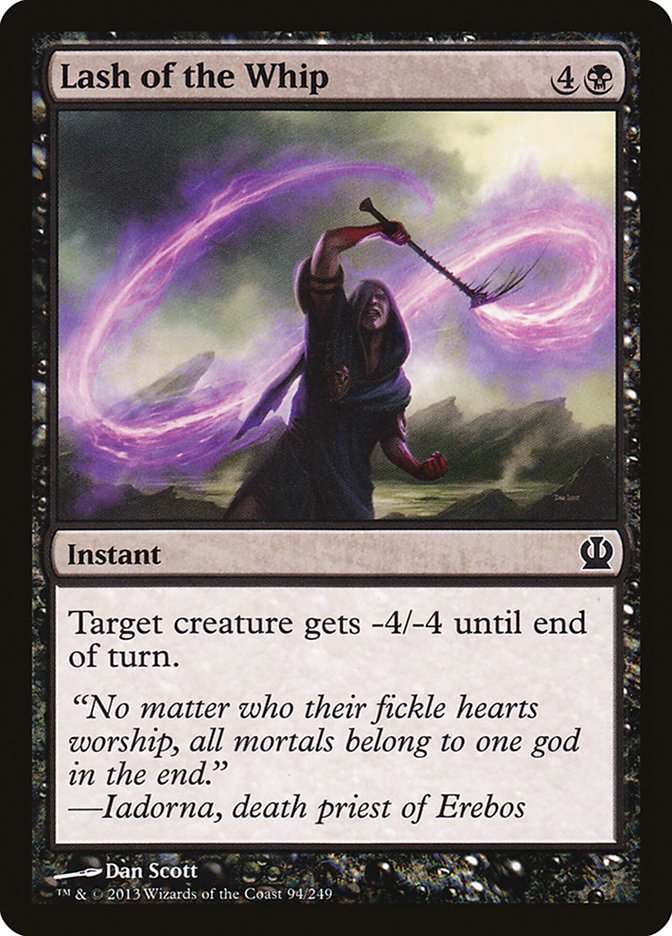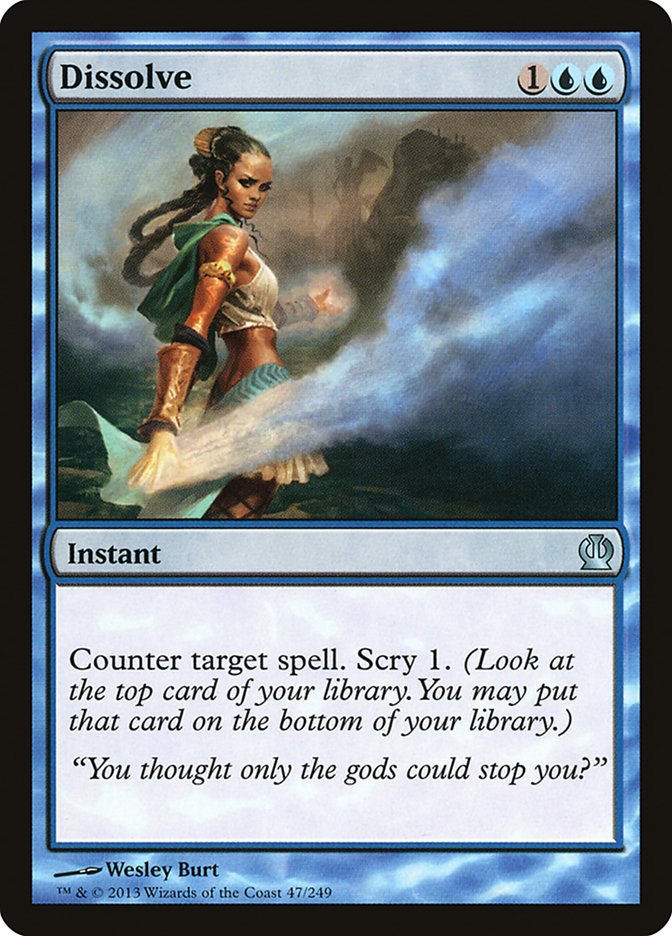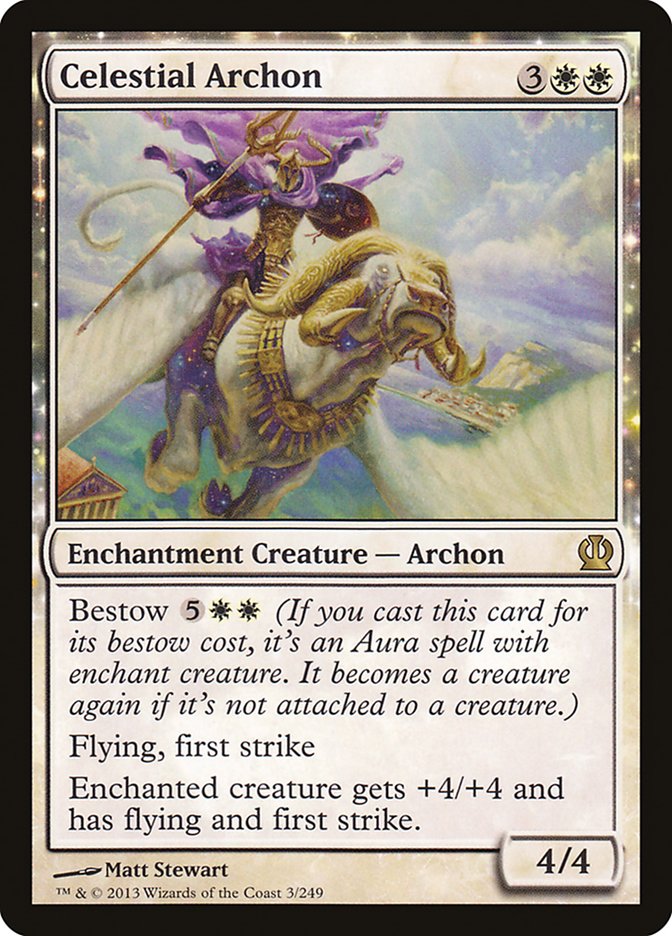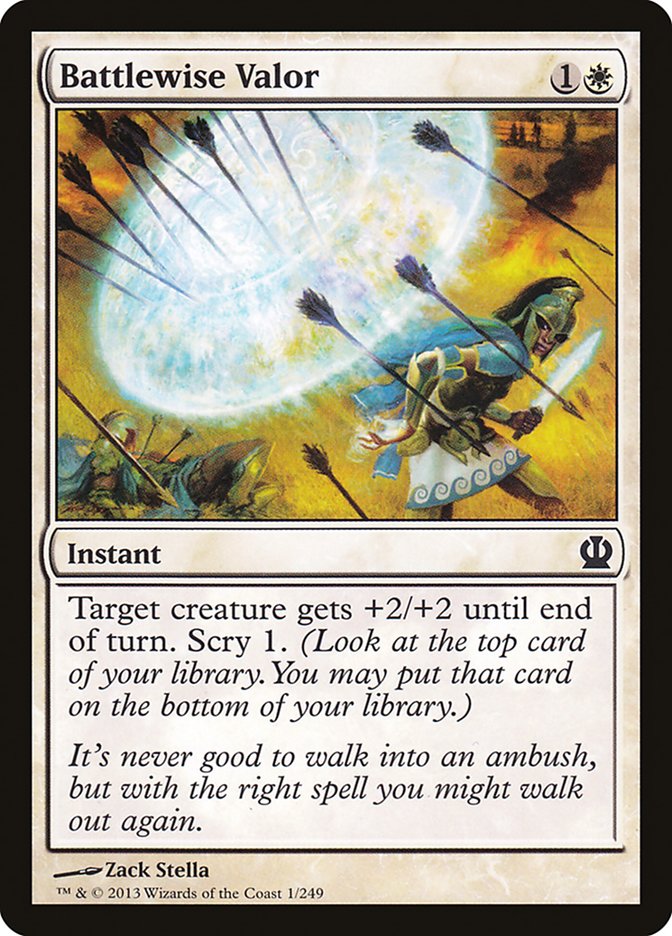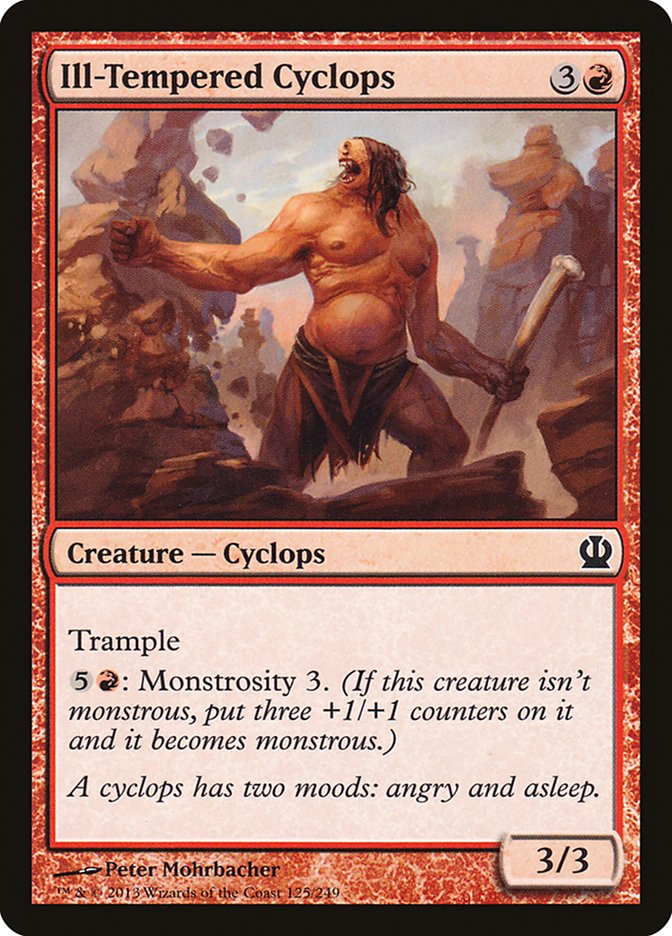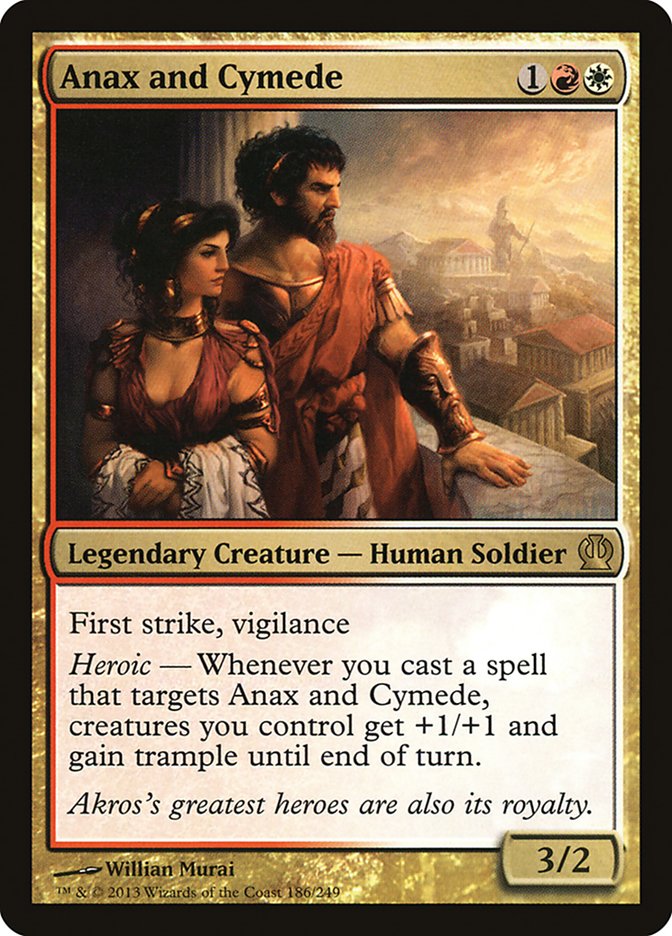One of the first things a new player begins to learn is how powerful removal can be in Limited Magic. Removal gets you out of sticky situations and brings you back into the game when you’re behind. It breaks up the opponent’s game plan, protects you against game-breaking bombs, and prevents your opponent from dominating you with Auras and combat tricks. From early experience, removal appears to be as important in Theros Limited as ever before.
What sets a card like Lash of the Whip apart from most other cards in the format is its flexibility, but this also means that it can be a tricky card to use properly. While you’ll typically cast your basic creatures at the first opportunity, Lash of the Whip demands two questions. First, should you cast it on this creature or wait for a different one? Second, once you’ve decided to cast it on this creature, how and when should you do so? Both questions are immensely complex and immensely important; for today, I’ll have to restrict myself to the latter: timing your removal spells.
Timing your removal spells is a skill that applies to all formats and is an important one to cultivate for any player hoping to have long-term success in Limited. That said, it will be particularly important in Theros because playing your removal at the wrong time might lead to your opponent blowing you out via the heroic mechanic. In fact, all five of Theros’ keyword mechanics—heroic, monstrosity, bestow, devotion, and scry—are important to the issue of timing your removal spells.
The Four Questions
Sorceries should be played during your own main phase, right?
Instants should be played at the end of the opponent’s turn or at the last possible moment, right?
Wrong. The word "instant" means flexibility, and any kind of restrictive thinking like this can only be harmful. In many cases, you should cast your instant-speed removal spell during your own main phase, just like a sorcery. Other times, you should cast it during your opponent’s upkeep, during their draw step, or during combat. When you cast it during combat, sometimes it should be before you block, and sometimes it should be after. The list stretches on and on; in this world of possibilities, how can you decide when to cast your spell?
There are four questions to consider.
1. Is there a risk of your opponent saving their creature? How can you minimize this risk? How bad will it be if they can successfully save their creature? Might there be other consequences besides the creature living? For example, if you try to Lightning Strike their Nessian Courser during combat and they play Savage Surge, you will take two extra damage.
2. Is there a chance of gaining additional value from this removal spell? Might they try to cast an Aura before combat or jump the gun by playing a combat trick too soon? Is it possible to entice a double block and perhaps kill two creatures with one spell?
3. What is the most convenient time for you to cast it? Could you use your mana on something else instead this turn? How likely are you to need your mana next turn? Is it best to cast your removal at the end of their turn so that you’ll have mana available just in case you need to cast your Dissolve? If you were to do that, how much would the extra damage you take during that combat step matter later in the game?
4. How can you most inconvenience your opponent? Holding mana open can sometimes have strange effects on players. Sometimes, even if they know exactly what you have, the presence of an instant-speed removal spell can make things difficult on them. How will your opponent know how many blockers to leave when they don’t yet know what creature you’re going to kill? How can they split their attackers between you and your planeswalker? How can they ever bestow their Nimbus Naiad when you could play a removal spell in response?
Saving Their Creature
Just as there are instant-speed removal spells, there are instant-speed ways to save a creature. Some examples in Theros include God’s Willing, Savage Surge, and Dissolve, just to name a few. When considering this possibility, the more information you can gather, the better. In a perfect world, you would know your opponent’s hand either through a card like Disciple of Phenax or through your superhuman powers of deduction (how has your opponent been acting; what cards would it make sense for them to be holding based on the way the game has played out?). Most often this won’t be the case, but it’s helpful if you can have some information about your opponent’s deck. Maybe you played a long game 1 where you saw a lot of cards.
Please bear with me on a small tangent. There’s some information to be gained by remembering what instants you passed in a draft. This is especially good to do in a team draft. It offers a small advantage in an individual draft as well but can be quite challenging. If after a draft you can’t remember many of the cards you passed, that’s okay; don’t worry about it. However, advanced drafters can begin working on their memory little by little to try to cultivate this skill. From my personal experience, you can improve your memory through physical fitness, by reducing stress, and simply by training your memory like you would a muscle.
In many cases, though, despite your best efforts, you’ll have very little information about what’s in your opponent’s hand or deck. In this case, you simply need to make your decision based on the tricks legal in the format, weighting appropriately for the likelihood that your opponent would have drafted the card in question and then decided to put it in their deck.
The most basic example comes from cards that counter your removal spell but have no other effect on the game—think Cancel, Negate, and Turn Aside. When these are the cards that you’re worried about, look for a time when your opponent is tapped out; this can be a great reason to cast an instant-speed removal spell on your own main phase. Simply killing a creature immediately after the opponent has tapped out for it can frequently be the cleanest and safest way to handle it.
Sometimes things aren’t so easy. Sometimes there’s no reason to believe that your opponent will ever tap out, and sometimes you decide that you cannot afford to be patient. In this case, the opponent’s upkeep can be the perfect time to cast an instant-speed removal spell. Your opponent has not yet drawn a card and therefore has the lowest chance of having the card in question in their hand. However, if they do, you’ve at least forced them to use their mana on their own turn and to decide whether or not to use the spell before they get to see what they draw for the turn.
Much more often, you’ll have to worry about your opponent saving their creature with some spell that has an additional impact on the game. To continue with the example from above, if your opponent is going to use Savage Surge to save their creature from Lightning Strike, you’d prefer this to happen on your own turn so that you won’t take additional combat damage from the pump spell. Or say you plan to chump block with a black creature if you fail to kill your opponent’s creature; it would be tragic if you waited until their upkeep to play Lash of the Whip and they saved it with God’s Willing naming black.
Here’s a guideline: if you want to kill your opponent’s creature before taking combat damage and expect that the first thing they will do on their turn is untap and attack, you should probably cast your removal spell on your own main phase.
Scry
Scry is a mechanic that has returned with Theros after not being a major player in Limited for some time. When attached to an instant-speed trick, scry falls in the category of additional impact on the game. Though its impact will typically be small, it’s still worth considering.
If your opponent is likely to save their creature with a spell that allows them to scry, when do they most want to scry? The simplest way to answer this question is to put your game in one of two categories.
Is this game time sensitive; is one player on track to win or gain an irreversible advantage unless a card comes off the top of the library to change things? Maybe one player is missing land drops or needs to find an answer to an unblockable creature. In this case, both players generally want to scry sooner rather than later, so therefore you might want to wait until after your opponent has drawn their card before casting your removal spell.
Or is your game going to continue indefinitely; is neither player likely to win with the resources currently available? In this case, both players generally want to wait to scry for as long as possible so that they can have more information when making their decision. Here it doesn’t matter very much, and you can feel fine casting your spell during your opponent’s upkeep.
Gaining Additional Value
The guideline that I offered above is a very safe way to play things; by following it, you minimize your chances of getting blown out. However, sometimes it’s appropriate to be a little more ambitious and allow yourself a chance to squeeze out a little more value.
Theros features a large number of enchant creature Auras—one that cantrips for each color, an Ordeal from each God, and a number of others. Many of these, like Scourgemark, Dragon Mantle, and the Ordeals, your opponents will be excited to cast before combat. Being able to kill a creature in response to such an Aura will gain you a huge advantage.
Consider how likely your opponent is to cast the Aura. This can depend a lot on the player, but it can also depend on how obvious you’ve made it that you have a removal spell. Did you hold up mana when you clearly had something else you could have done with it? These things can be difficult to gauge in a tournament setting, but on turn 3 of a random game, I believe that most players will probably cast their Scourgemark into two open mana if they have no other play to make. So early in the game, you can probably afford to wait until combat to use your Spark Jolt or Pharika’s Curse.
Bestow
Bestow is a new mechanic in Theros. It basically amounts to "an Aura without the chance of getting two-for-oned." Nonetheless, bestow costs tend to be quite expensive, and the ability to kill a creature in response to bestow can mean a large tempo loss. Additionally, you wouldn’t want to blow a removal spell too early and simply watch your opponent bestow onto their next-best creature. Bestow is one more reason to consider waiting until combat to cast your removal spell.
Combat Tricks
If you can bait your opponent into casting a combat trick like Battlewise Valor and respond by removing the creature, you’ve achieved the same great effect as if you were to kill it in response to an Aura. While it’s unlikely that your opponent will fire off their Battlewise Valor on turn 4 when you’re at sixteen life, they may do it later in the game when it represents a lethal attack.
Blocking can also be a great way to entice your opponent into playing their combat trick. Let’s say your opponent attacks you with Borderland Minotaur and you intend to cast Lash of the Whip on it. You might as well block with your two 2/2 creatures even though you don’t intend to trade them with the Minotaur. Your opponent might easily smell blood and jump the gun on their Battlewise Valor, and you can respond with Lash of the Whip in order to kill two birds with one stone.
I recommend that every tournament player learn the exact details of the entire combat phase and how priority passes back and forth between players. Also, although it can be a pain in the neck, I recommend being as precise as possible in going through each step. When your opponent attacks you, you should say, "I’m not blocking; do you have any effects before damage?" This way you give them every opportunity to use their combat trick, and if you do it every time you have mana available, you won’t tip them off about whether or not you have an instant-speed removal spell.
Monstrosity
Monstrosity is one reason why instant-speed removal spells are as important in Theros Limited as ever before. In particular, it changes Griptide and Voyage’s End from "good cards" to game-swinging powerhouses. Monstrosity gives a player the option to invest a huge amount of mana into one creature in exchange for making a threat capable of dominating the game on its own.
Note that cards like Keepsake Gorgon and Stoneshock Giant have triggered abilities upon becoming monstrous. These abilities will never even trigger in the first place if the creature is removed in response to activating monstrosity.
The chance to blow your opponent out in response to monstrosity is another reason to be patient with your instant-speed removal. However, the issue can be complicated if a savvy opponent sees through your plan. Consider this example:
You have a Lightning Strike, but you pass the turn. Your opponent untaps with Ill-Tempered Cyclops and five lands. They play a sixth land and attack you. You tell your opponent you’re not blocking, and they tell you they have no effects before damage. Now you cannot cast your Lightning Strike on the Cyclops because your opponent could simply activate monstrosity in response and save their creature.
What will you do in such a situation? Is it a huge problem for you to take the three damage? Do you think your opponent is likely to make such a play? If so, perhaps you should cast Lightning Strike sooner rather than later.
Heroic
Heroic is the mechanic that most complicates the issue of timing your removal spells. First, it’s difficult to gauge the value of your opponent’s heroic creature until you know how many spells they have that can target it. However, by then it might be too late. Note that heroic is an ability that triggers upon your opponent’s spell being cast, so even if you destroy the creature in response, the effect of the heroic ability will still happen (if it has an effect that goes beyond just the heroic creature itself).
The worst thing that can happen to you is that your opponent saves their heroic creature from a removal spell by casting a spell that targets it. This will negate your removal spell and get the effect that they (presumably) built their deck around; you’re going to be in trouble! If you want to be as safe as possible, try to kill the heroic creature immediately on your own turn.
On the flip side, your opponent is exceptionally likely to try to cast an Aura or combat trick that targets their heroic creature. After all, that’s why they put all of these cards in their deck! So if the heroic ability is not too devastating and you think you can afford to be patient and wait for a two-for-one, then that might be the right option as well.
I wish I could give you an easy answer about when to kill your opponent’s heroic creatures, but if such an easy answer existed, I would not have had to devote an entire article to the topic. The first thing you should consider when you see a heroic creature across the table is that your opponent probably built their deck with the specific goal of triggering and protecting their heroic creatures. You have an especially high chance of getting a two-for-one, but you also have an especially high chance of getting blown out. Perhaps if you’re winning, you should play it safe and kill the creature immediately, and if you’re behind, you should look for extra advantage in a two-for-one—but even this is oversimplifying. Consider all the factors and make an educated decision.
Convenience For You
When I use the word "convenience," you may think about how comfortable your chair is or how much elbowroom you have when the person next to you rolls out their giant playmat. However, in this case I’m using "convenience" to refer to a strategic concept. It has to do with the sequencing and timing of your cards—basically, how smoothly and efficiently you’re able to play your cards.
Imagine that I leave up four mana for Divine Verdict in an effort to kill your Anax and Cymede. But you, my opponent, don’t attack with your Anax and Cymede and instead simply play another creature and pass the turn. I haven’t lost my Divine Verdict; nothing is explicitly stopping me from destroying Anax and Cymede with it later in the game. However, you have inconvenienced me in the sense that my mana is wasted and I’ll have to hold up mana again next turn if I want the same option. Although none of my cards have been lost, you can see how such a thing could potentially change the outcome of a game.
So what is convenient for you? If your hand contains a three-drop, four-drop, and five-drop creature, then you won’t have a convenient time to cast your Pharika’s Curse any time after turn 2. Perhaps it’s worthwhile to kill that Vaporkin right away.
Do you really need to hit your land drop this turn? Maybe your scrying needs to be done as soon as possible, and you want to cast that Magma Jet during your own upkeep.
Are you very worried about that Hythonia, the Cruel that beat you in game 1? Maybe you should take some extra damage so that you can play Griptide at the end of the opponent’s turn; that way you can hold up Dissolve at all times.
Inconvenience For Your Opponent
I’d like to close with a few words about the power of holding mana open. Anyone who’s ever played with Huntmaster of the Fells knows the joy of having an opponent completely tapped out or completely out of cards. It makes things so simple! You can just make the most powerful play that you can find with your own cards, and you don’t have to consider the risk of things going wrong. In short, you go for it.
The last thing you want is for your opponent to go for it when you have nothing. You don’t want them to trigger their Ordeal of Thassa! You don’t want them to make their Stoneshock Giant monstrous! You don’t want them to play two Battlewise Valors on their Fabled Hero!
Thankfully, these are usually things that your opponent cannot (will not) do when you have all of your mana available. This is one of the benefits of waiting as long as possible to cast your removal spell. When you do use your Lash of the Whip on your own main phase, it gives your opponent more flexibility to go for it on their turn by using bestow, casting an Aura, or firing off their combat trick.
Try—when you can—to make things inconvenient for your opponent.
Timing your removal spells properly can be a real challenge. It’s a skill that comes with long experience, but more importantly it takes effort and presence of mind in the game. I wasn’t able to give you the easy answers or the golden rules that I try so hard to offer, but if I’ve made you give five seconds of extra thought to the Triton Fortune Hunter that comes down across the table, then I’ve done my job. Carry these ideas with you through the Theros Limited season and into future formats to come.

